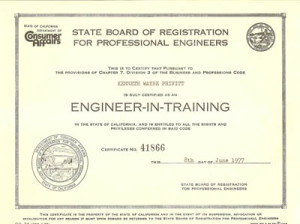Coming from an undergraduate background in Physics, I had never been introduced to the concept of a Professional Engineer (PE) license. In my first year of grad school, one of my colleagues in Chemical Engineering had recently gotten his and I saw the letters PE dangled behind names every now and then, but, even after graduating with my PhD in Chemical Engineering, I still had very little idea how or why one obtained a PE license.
That all changed once I started at Exponent. Regardless of background, earning a PE license is strongly encouraged at Exponent and a cursory glance through the consultant roll call (http://www.exponent.com/professionals/results/) confirms that many follow through. While a PE license is generally not required or even beneficial for engineering working in industry, which includes essentially all Chemical Engineers, it is required for most independent work and strongly recommended for consulting. This is driven by the litigious nature of much of Exponent’s work. Attorney’s will frequently grill experts on qualifications and certifications, and obtaining a PE license strengthens credibility in the eyes of many in the legal system.
That said, despite my non-traditional background, sometime in August I started the ball rolling to get my PE license. The first step to become an Engineer in Training (EIT). In order to become an EIT, one must have four years of experience in engineering and pass the Fundamentals of Engineering exam administered by NCEES (http://ncees.org/exams/fe-exam/). It turns out that both of these steps became hurdles for me.
First, the experience. While NCEES administers the FE and PE Exams, the actual licensing process is done through the State Department of Regulatory Affairs (Colorado DORA for me). These folks are seriously overworked and dealing with non-traditional educations is a total pain for them. A typical examinee with a 4-year, ABET accredited, engineering undergraduate degree has no problem sitting for the FE exam immediately after graduating or even before in some cases. An atypical examinee, with a 4-year Physics BA and Chemical Engineering PhD like, has a much more difficult time. I had to negotiate with DORA for something like 3 months before I could get approved to take the FE Exam. A tip for those in similar situations: be persistent and polite. the DORA staff is overworked and determining engineering experience is not something they want to spend a lot of time on.
The second hurdle is the FE Exam itself. For Chemical Engineering, the exam has something like an 80% pass rate. I don’t think I’ve been in the bottom 20% of anything I’ve even done in my life, so I just registered and reasoned I didn’t need to study. I was wrong. This is a bad idea. Luckily, two weeks before I was scheduled to take the exam, I logged in to the NCEES practice exam online and was humiliated. Despite flying through my graduate ChemE coursework, I had absolutely no idea how to do how to do the undergraduate ChemE problems that were found on the exam. No idea. I scored less than 50% on the practice exam, nailing essentially on the math problems and the problems that could be reasoned out using units alone. Despite some reports on the internet, I wasn’t confident that 50% is a passing score and would have been terribly embarrassed if I failed. I found myself with two weeks to teach myself all of undergraduate Chemical Engineering.
I had two weeks to learn the fundamentals of fluids, thermodynamics, heat transfer, mass transfer/separations, engineering economics, and controls. To do this, I would recommend one resource and one resource only–www.learncheme.com. Faculty at the University of Colorado have invested significant time into distilling the fundamentals of Chemical Engineering into easy-to-digest, 5-20 minute videos and have outlined a series of videos designed specifically for studying for the FE Exam. Those two weeks before the exam, I got up a little earlier every morning before work, watched a video or two, and diligently repeated until exam time came. And, it worked! While I was previously a little embarrassed in grad school having no idea how to read a McCabe-Thiele diagram or calculate flow losses through a pipe, after 15-20 hours of studying, I now would feel totally confident teaching these undergraduate courses.
Despite the headaches that came with it, I am now proud to call myself Colorado Engineer in Training #71087. Now I just have to wait 6 years to take the PE exam…
